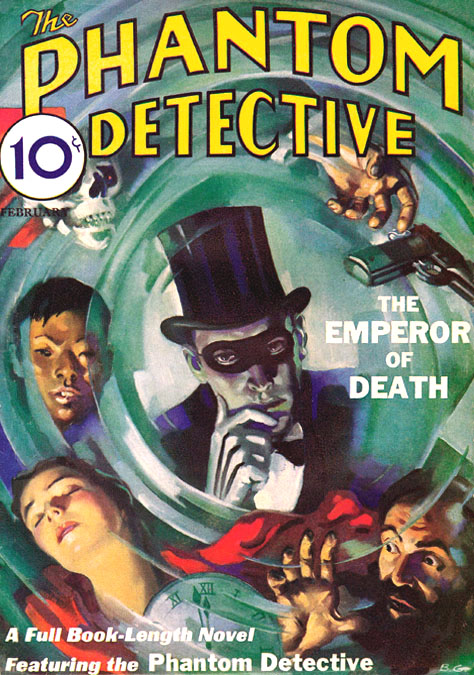Who knows what evil lurks in the hearts of men? The Shadow knows!!!
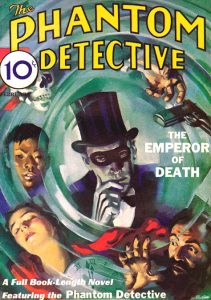 In the spring of 1931, THE SHADOW MAGAZINE was introduced to readers by Street & Smith Publications. Employing the talents of author Walter B. Gibson, the magazine proved an instant hit. Planned as a quarterly, this first “hero” pulp became a monthly following its first two issues. A year later, it became a semi-monthly, appearing twice monthly until early 1943. In 1937, Gibson teamed with scriptwriter Edward Hale Bierstadt to develop a radio program for the Mutual Broadcasting System. It was here that actor Frank Readick, Jr. uttered the famous words quoted above that have since become part of the American idiom.
In the spring of 1931, THE SHADOW MAGAZINE was introduced to readers by Street & Smith Publications. Employing the talents of author Walter B. Gibson, the magazine proved an instant hit. Planned as a quarterly, this first “hero” pulp became a monthly following its first two issues. A year later, it became a semi-monthly, appearing twice monthly until early 1943. In 1937, Gibson teamed with scriptwriter Edward Hale Bierstadt to develop a radio program for the Mutual Broadcasting System. It was here that actor Frank Readick, Jr. uttered the famous words quoted above that have since become part of the American idiom.
By 1932, Street & Smith was planning other single-character magazines, hoping to emulate the high-flying SHADOW MAGAZINE. The leading pulp magazine publisher would introduce three titles in 1933, including DOC SAVAGE MAGAZINE. Other publishing houses were also noticing the strong sales. The first to the starting gate would be Ned Pines’ Standard Magazines, the pulp chain that will be feted at this year’s PulpFest in Columbus, Ohio.
The first of the so-called hero pulps inspired by Walter Gibson’s “Dark Avenger” was THE PHANTOM DETECTIVE. Created by D. L. Champion (whose wife was a native of Columbus) and launched by Ned Pines’ Thrilling Group, the Phantom was the alter ego of man-about-town Richard Curtis Van Loan. A veteran of the World War I, this moneyed playboy was bored with life until a family friend recommended he “try his hand at solving a mysterious crime which had stumped the police.” His initial success led Van Loan to dedicate his life and fortune to combating crime, making the Phantom “a name known and admired by the police of every nation.”
The first issue of THE PHANTOM DETECTIVE was dated February 1933; it would be followed that year by other single-character pulps including G-8 AND HIS BATTLE ACES, NICK CARTER, and THE SPIDER. The Summer 1953 issue would be the final number of the Thrilling pulp. It was the longest-lived of the hero pulps, lasting for just over twenty years and a total of 170 issues.
While the Great Depression savaged other fiction genres, the pulp heroes of 1933 surged forward, their magazines flying off America’s newsstands faster than they could be printed. Street & Smith’s DOC SAVAGE and NICK CARTER followed THE PHANTOM DETECTIVE to the racks, while Thrilling introduced an air hero, inspired by the success of its own SKY FIGHTERS, a pulp filled with the adventures of flying aces of the First World War and “especially sought after by boys raised on the courageous exploits of fathers and uncles who had served in the Great War, boys who kept themselves busy building model planes constructed of balsa wood.”
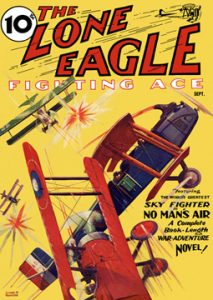 Borrowing one of the nicknames given to Charles Lindbergh following his nonstop flight from New York to Paris, Standard Magazines released THE LONE EAGLE. Telling the heroic adventures of Air Intelligence Agent John Masters, “the world’s greatest Sky Fighter,” the pulp debuted in the late summer of 1933. “Masters showed a natural affinity for a stuttering machine-gun and as his natural proficiency increased, he built up a dark and terrible reputation about his name. He became the ‘Lone Eagle’ of the skies . . . He showed an indomitable courage and a dynamic driving power, in pushing to a successful conclusion his secret missions. Many men feared him, many hated him—an occasional one loved him.”
Borrowing one of the nicknames given to Charles Lindbergh following his nonstop flight from New York to Paris, Standard Magazines released THE LONE EAGLE. Telling the heroic adventures of Air Intelligence Agent John Masters, “the world’s greatest Sky Fighter,” the pulp debuted in the late summer of 1933. “Masters showed a natural affinity for a stuttering machine-gun and as his natural proficiency increased, he built up a dark and terrible reputation about his name. He became the ‘Lone Eagle’ of the skies . . . He showed an indomitable courage and a dynamic driving power, in pushing to a successful conclusion his secret missions. Many men feared him, many hated him—an occasional one loved him.”
Those words, written by F. E. Rechnitzer, appeared in “No Man’s Air,” the lead novel in the first issue of the new hero pulp. A former World War I Allied pilot and prisoner-of-war, Rechnitzer is believed to have written many of the adventures of The Lone Eagle, hidden behind the “Lt. Scott Morgan” house name; Robert Sidney Bowen probably contributed most of the later novels. In all, 75 tales of “the world’s greatest Sky Fighter” would appear through the spring of 1943, when the magazine would fly off into the sunset as THE AMERICAN EAGLE.
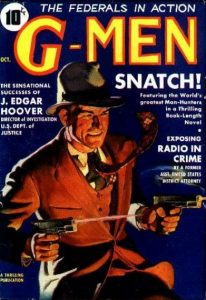 In the early thirties, lawman J. Edgar Hoover was trying to build a “super police force” to deal with the crime then rampant in America. To help his cause, Hoover embarked on a spirited publication relations campaign, creating a radio program that dramatized actual cases of the Bureau. He also tried to put together a comic strip, WAR ON CRIME. Although these attempts did not get very far, Hoover had great success in the pulp market. By 1936, there were four magazines dedicated to the heroics of the FBI, including the one that started it all, Better Publications’ G-MEN. The “Ace of the FBI,” Special Agent Dan Fowler, was no “Man of a Thousand Faces.” Straight-laced and completely dedicated to the Bureau, this cross between Dick Tracy and DRAGNET’S Sergeant Joe Friday tormented kidnappers, drug pushers, bank robbers, saboteurs, arsonists, racketeers, and other miscreants for 112 adventures, beginning in the October 1935 G-MEN. Most of the early Fowlers were written by George Fielding Eliot using the house name of C. K. M. Scanlon. Later yarns were credited to the actual authors–Robert Sidney Bowen, Norman Daniels, Laurence Donovan, G. T. Fleming-Roberts, Jean Francis Webb, Manly Wade Wellman, and others. The magazine was discontinued following its Winter 1953 issue.
In the early thirties, lawman J. Edgar Hoover was trying to build a “super police force” to deal with the crime then rampant in America. To help his cause, Hoover embarked on a spirited publication relations campaign, creating a radio program that dramatized actual cases of the Bureau. He also tried to put together a comic strip, WAR ON CRIME. Although these attempts did not get very far, Hoover had great success in the pulp market. By 1936, there were four magazines dedicated to the heroics of the FBI, including the one that started it all, Better Publications’ G-MEN. The “Ace of the FBI,” Special Agent Dan Fowler, was no “Man of a Thousand Faces.” Straight-laced and completely dedicated to the Bureau, this cross between Dick Tracy and DRAGNET’S Sergeant Joe Friday tormented kidnappers, drug pushers, bank robbers, saboteurs, arsonists, racketeers, and other miscreants for 112 adventures, beginning in the October 1935 G-MEN. Most of the early Fowlers were written by George Fielding Eliot using the house name of C. K. M. Scanlon. Later yarns were credited to the actual authors–Robert Sidney Bowen, Norman Daniels, Laurence Donovan, G. T. Fleming-Roberts, Jean Francis Webb, Manly Wade Wellman, and others. The magazine was discontinued following its Winter 1953 issue.
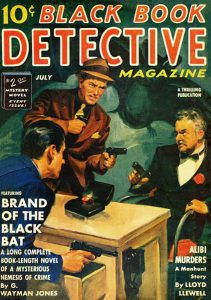 BLACK BOOK DETECTIVE MAGAZINE had actually been around for quite a few years when the story, “Brand of the Black Bat” appeared in its July 1939 number. The pulp, which ran for twenty years, had debuted in the late spring of 1933. During its initial years, it was a detective pulp, Standard’s answer to such stalwarts as BLACK MASK and DIME DETECTIVE. A monthly magazine, it published between three and eight stories in each issue, featuring detective yarns by writers such as Hugh B. Cave, Charles Green, Philip Ketchum, Johnston McCulley, Barry Perowne, Richard Sale, Lawrence Treat, and many others. In the summer of 1939, its make-up changed when BLACK BOOK DETECTIVE became a hero pulp, featuring the adventures of The Black Bat. The creation of the prolific Norman Daniels, the Bat is actually Tony Quinn, a young district attorney, blinded by acid. Eventually, a surgeon secretly operates on Quinn, transplanting the eyes of a slain police sergeant into the scarred attorney. After his bandages are removed, Quinn can see perfectly in the dark. Soon thereafter, the Black Bat is born. According to the late pulp fan, Lester Belcher, “The Black Bat novels were fast-moving, exciting, and held your interest. Quinn was a true American, fighting for justice in the only way he knew how.” Through the final issue of BLACK BOOK DETECTIVE, dated Winter 1953, the Black Bat appeared 62 times. Two more novels were left unpublished following the magazine’s demise. Except for a half-dozen stories published during the early forties, as well as the final published Black Bat novel, all of Quinn’s exploits were written by Norman Daniels.
BLACK BOOK DETECTIVE MAGAZINE had actually been around for quite a few years when the story, “Brand of the Black Bat” appeared in its July 1939 number. The pulp, which ran for twenty years, had debuted in the late spring of 1933. During its initial years, it was a detective pulp, Standard’s answer to such stalwarts as BLACK MASK and DIME DETECTIVE. A monthly magazine, it published between three and eight stories in each issue, featuring detective yarns by writers such as Hugh B. Cave, Charles Green, Philip Ketchum, Johnston McCulley, Barry Perowne, Richard Sale, Lawrence Treat, and many others. In the summer of 1939, its make-up changed when BLACK BOOK DETECTIVE became a hero pulp, featuring the adventures of The Black Bat. The creation of the prolific Norman Daniels, the Bat is actually Tony Quinn, a young district attorney, blinded by acid. Eventually, a surgeon secretly operates on Quinn, transplanting the eyes of a slain police sergeant into the scarred attorney. After his bandages are removed, Quinn can see perfectly in the dark. Soon thereafter, the Black Bat is born. According to the late pulp fan, Lester Belcher, “The Black Bat novels were fast-moving, exciting, and held your interest. Quinn was a true American, fighting for justice in the only way he knew how.” Through the final issue of BLACK BOOK DETECTIVE, dated Winter 1953, the Black Bat appeared 62 times. Two more novels were left unpublished following the magazine’s demise. Except for a half-dozen stories published during the early forties, as well as the final published Black Bat novel, all of Quinn’s exploits were written by Norman Daniels.
Scattered throughout Standard’s anthology titles are other so-called pulp heroes. D. L. Champion’s “Mr. Death,” most likely, helped the author land the assignment to pen the early adventures of The Phantom Detective. Published under the house pseudonym of G. Wayman Jones in THRILLING DETECTIVE from February 1932 through October 1932, Mr. Death is man-about-town James Quincy Gilmore. His father is slain by the vicious Murder Club, led by nine unknown individuals. Gilmore swears vengeance on them as Mr. Death and in each part of the story, tracks down and kills each murderer, leaving a calling card reading “Alias Mr. Death.” In the last story, after eliminating Number One, Mr. Death “kills” himself in a plane crash. The entire series has been reprinted by Altus Press.
Perley Poore Sheehan offered six tales of “Kwa of the Jungle” to readers of THRILLING ADVENTURE during the early thirties. Writing as Paul Regard, Sheehan relates the story of Nathaniel Rahan, orphaned after a plane crash kills his parents in a lost African valley. Adopted into a tribe of chimp-like pre-humans known as “The Men That Are Not Yet Men,” he is called “Kwa, the Golden One” and taught the ways of the jungle by a wise old chimpanzee named Kek. Encountering spider men, minotaurs, and other dangers in six “thrilling” adventures originally published between August 1932 and May 1933, the entire series has been reprinted by Pulpville Press.
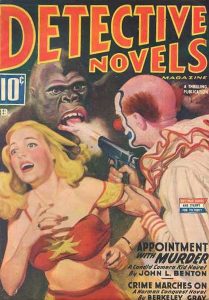 Standard had been publishing DETECTIVE NOVELS for over a year when it introduced Norman Daniels’ “Candid Camera Kid” to readers of the Thrilling line of pulp magazines. Most likely inspired by the popularity of George Harmon Coxe’s Flashgun Casey, the ace photographer for a Boston newspaper whose adventures appeared in BLACK MASK and a pair of B movies, Daniels’ twenty-three tales of the Kid were published behind the John L. Benton house name. They debuted in the June 1939 issue of DETECTIVE NOVELS and ran through the June 1944 number. Two additional tales appeared in THRILLING DETECTIVE under the G. Wayman Jones byline. There’s a great article about the Kids’ stories written by Monte Herridge and published in the June 2001 issue of Mike Chomko’s long-lamented pulp fanzine PURPLE PROSE.
Standard had been publishing DETECTIVE NOVELS for over a year when it introduced Norman Daniels’ “Candid Camera Kid” to readers of the Thrilling line of pulp magazines. Most likely inspired by the popularity of George Harmon Coxe’s Flashgun Casey, the ace photographer for a Boston newspaper whose adventures appeared in BLACK MASK and a pair of B movies, Daniels’ twenty-three tales of the Kid were published behind the John L. Benton house name. They debuted in the June 1939 issue of DETECTIVE NOVELS and ran through the June 1944 number. Two additional tales appeared in THRILLING DETECTIVE under the G. Wayman Jones byline. There’s a great article about the Kids’ stories written by Monte Herridge and published in the June 2001 issue of Mike Chomko’s long-lamented pulp fanzine PURPLE PROSE.
Another Daniels’ character, “The Eagle,” was described as “the master spy-fighter of them all.” An ace counter-espionage agent, he had a reputation known from Tokyo to Berlin. As the first issue of THRILLING SPY STORIES, dated Fall 1939, proclaimed: “The Eagle, wise in the ways of spies and trained to detect the hundred and one subterfuges to which spies resort, fights the enemy with its own undercover weapons, and handles those weapons with a skill brought to perfection by a tireless body, an agile brain, and a fighting heart imbued with the love of his country and her democratic institutions.” The series ran throughout the entire run of the magazine–four issues–with the last dated Summer 1940. A fifth story, “Gold of the Gestapo,” ran in the December 1940 issue of POPULAR DETECTIVE. The entire series has been reprinted by Altus Press.
As part of its celebration of the Thrilling Group, PulpFest 2015 is proud to welcome Altus Press publisher and 2012 Munsey Award winner Matt Moring; 1979 Lamont Award winner and author of “The Wild Adventures of Doc Savage and Tarzan” Will Murray; pop culture expert and 2014 Inkpot Award winner Michelle Nolan; and popular culture Professor Garyn G. Roberts, who was awarded the Munsey in 2013, for a presentation entitled “Thrilling Heroes of Standard’s Pulps and Comics.” Scheduled for Friday evening, August 14th, at 10:40 PM, it will examine the evolution of the Standard hero in both pulp magazines and comic books. Thrilling’s heroes of the detective and western genres will be dissected on Thursday, August 13th.
For the next few days, we’ll be discussing Standard’s heroes to call attention to this “Thrilling Presentation!!!” Join us by visiting pulpcon.org on Saturday, June 20th, for an examination of the Thrilling pulp heroes of the forties. On Sunday, we’ll turn our attention to the comic book heroes of Standard, Better, Nedor, and Visual Editions.
(Following the success of Street and Smith’s single-character pulp, THE SHADOW MAGAZINE, Ned Pines entered the hero pulp market with THE PHANTOM DETECTIVE. Its first issue was dated February 1933 and featured front cover art by Bertram James Glover, an illustrator and landscape artist who began painting pulp magazine covers in 1927.
Borrowing one of the nicknames given to Charles Lindbergh following his nonstop flight from New York to Paris, Standard’s THE LONE EAGLE debuted behind a cover painted by Eugene M. Franzden, an artist whose work regularly appeared as interior story illustrations and covers for many aviation pulp magazines including the September 1933 issue of the Thrilling air-hero pulp.
Emery Clarke created the front cover art for the initial appearances of both Dan Fowler in the October 1935 G-MEN and Norman Daniels’ Black Bat in the July 1939 issue of BLACK BOOK DETECTIVE MAGAZINE. Clarke was a freelance artist who painted covers for ACTION STORIES, DOC SAVAGE, FIGHT STORIES, SHORT STORIES, STAR WESTERN, TEN DETECTIVE ACES, TOP-NOTCH, and other pulps. He also created covers for LIBERTY, THE SATURDAY EVENING POST, and other slick magazines.
Rudolph Belarski’s cover to the February 1944 issue of DETECTIVE NOVELS is one of many covers that the talented artist painted for Ned Pines’ “Thrilling Group” of pulp magazines. Belarski got his start with the pulp industry in 1928 through Dell Publications, doing interiors and covers for adventure pulps about World War I. He later worked for Fiction House and the Munsey line of pulp magazines. By 1935, he was one of Ned Pines’ top artists at Standard Publications. To learn more about this talented artist, read “The Thrilling Adventures of Rudolph Belarski,” posted to our website on Sunday, June 14, 2015.)

